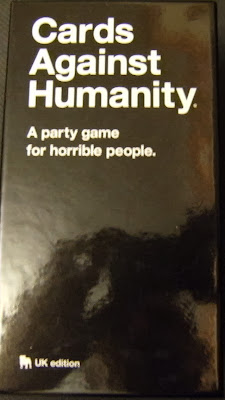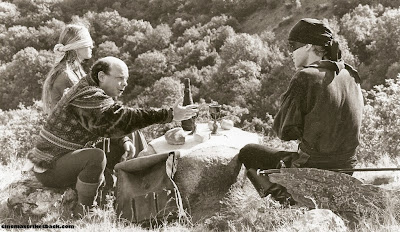WARNING!
This review features subjects which may cause offence. If you are easily offended by ANYTHING then for the love of God stop reading now!!!
So far at Games & Tea we've stuck very closely to non-offensive games. Certainly most specialist games do tend to have complicated rule sets which can make them largely inaccessible to younger players, but with enough time and teaching they can plausibly be enjoyed by the entire family. Every now and then, however, a game comes along which is undeniably for adults only, and it's with utmost pleasure that we're able to bring you a review of the newly-released (and long-awaited) UK Edition of Cards Against Humanity, a party game for 4 or more people.
 |
| Because horrible people like parties too. |
Cards Against Humanity is a Kickstarter success story, and has found itself a very strong fanbase thanks to its wickedly dark sense of humour and very basic game mechanic. The box itself features no unnecessary ornamentation; what you see on the box is exactly what you'll find inside the box. This is a party game for horrible people, and as long as you have a dark and twisted sense of humour and can make a joke out of any subject, you'll fit right in. If, on the other hand, there is ANY subject at all which you find too sensitive, then it's best to steer clear, because the odds are it features somewhere in this game!
But we're getting ahead of ourselves. Upon opening the box, players will be greeted by a short rules card, and a rather generously-sized stack of cards; 90 black and 460 white. These two decks are separated out and given a decent shuffle, and then each player is dealt an opening hand of 10 white cards. The player who most recently pooed (yes, this is an official rule) is the first player to take on the role of The Card Tsar, and the game is ready to begin.
The Card Tsar takes the top card off the black deck, and reads it out to the rest of the group. All of these cards take the form of either a question, or a phrase where the key words have been left as blank. Many of these questions lend themselves easily to innuendo or offense, but some are actually quite innocent at first glance, which can actually make the next part of the game that much darker.
With the question/phrase presented to the group, the other players must pick a white card from their hand as their answer, and hand the card face-down to The Card Tsar. Once all players have submitted their responses, The Card Tsar shuffles them together and reads them aloud one by one to the group. When all of the submitted white cards have been read out, The Card Tsar chooses their favourite, and the player who submitted that white card scores an Awesome Point. The players then draw back up to 10 cards, and the next player to the left takes on the role of The Card Tsar for the next round. Play continues this way until one player reaches a number of Awesome Points decided at the beginning of the game.
That's the basics of Cards Against Humanity, and it's easy to see how with such a simple mechanic it's achieved such popularity. One of the greatest parts of the game is playing to The Card Tsar's sense of humour. If you have a set gaming group and you're very familiar with what makes eachother tick, then you can tailor your white cards accordingly. A card which one player may find hilarious might not make another player tick at all, so sometimes you can have an agonising wait on your hands, waiting for that perfect play.
This may be a perfect example. Nicolas Cage has well and truly become an internet legend, and his bee-based demise in The Wicker Man is a firm favourite amongst his fans. To someone who appreciates this, the card combination above is virtually unbeatable, but to those unfamiliar with his cult status then it would probably only cause confusion.
 |
| They're in his eyes. Oh dear. |
On top of this basic rule set, there are some optional house rules which can enhance gameplay, or make things a little easier for players struggling with their white cards. A popular rule is "Rando Cardrissian", where, during each round, one white card is randomly pulled from the deck and added to the stack of answers. This card belongs to the non-existent extra player, and if he wins the round then he scores an Awesome Point just like everyone else. If Rando wins the game, then all of the real-life players suck. Other rules allow for players to discard a white card if they don't understand it (but they must face the humiliation of admitting their ignorance to the group), or spend an awesome point to discard as many cards from their hand as they wish, and draw back up to 10.
As you can probably tell from the way we've spoken about it, we're very big fans of Cards Against Humanity, and everyone we've played it with has enjoyed it thoroughly. However, we can't stress enough just how much this game can offend if played with the wrong crowd. Whilst most of the black cards aren't too bad in themselves, there are a couple of risqué cards, such as "During Michael Jackson's final moments, he thought about [blank]"
The white cards, however, are where the potential for offensiveness truly lies, and where Cards Against Humanity earns its description of "a card game for horrible people". Some of the worst white cards include "Auschwitz", "Wanking into a pool of childrens' tears", "Chunks of dead prostitute" and "AIDS" (there's a very good reason we put that warning at the front of this review). This makes Cards Against Humanity something of a marmite game, as most people will either love the sense of humour or loathe it for being in poor taste.
The Good Points
- Cards Against Humanity may well be the easiest-to-learn game we've ever played. One player poses a question, the other players answer it. There really is nothing more to learn, so absolutely anyone with a dark sense of humour can play.
- The game is absolutely hilarious to play, and is one which you genuinely don't mind losing. Of course it's nice to win, but Cards Against Humanity is more about laughing at the card combinations rather than fighting tooth and nail for points, which does make it a perfect party game.
- Nicolas Cage.
- Bees.
The Bad Points
- Due to the way it plays, Cards Against Humanity does need a minimum of 4 players to function smoothly, so really is more of a party game than a regular games night game (unless your games nights do actually feature 4+ people, in which case you're sorted!)
- We should mention the overall politically incorrect tone of the game; anyone easily offended will not enjoy playing. However, on account of the warning at the top of the page, those people should have stopped reading by now, and so this point is no longer valid.
Recommended Number of Players: 4+ (The more the merrier!)
In order for The Card Tsar to have a good selection each round, Cards Against Humanity recommends a minimum of 4 players, which can be augmented with addition of Rando Cardrissian (who turns out to be an unerringly good player!). The fantastic thing with this game is that it does improve with more players, and the best games we've played have featured 8 of us including the dastardly Rando.
Average Game Time: 30-90 minutes
We are giving quite a wide window here, but that's because it's hard to put an average time on Cards Against Humanity. It entirely hinges on the number of players, and the target number of Awesome Points. Typically at Games & Tea we play to 5 Awesome Points, and with 4-5 players this takes around 45 minutes.
Replayability: High
With so many cards in the set, and so many combinations available, Cards Against Humanity is extremely replayable. Even if you reach the stage where you've seen every white card a dozen times, it's just as much fun to see someone else's reactions to the cards when you introduce them to the game for the first time.
The Future: Bright (or should that be dark?)
As well as having a great deal of replayability in the basic box set, there are already 3 expansions available, each featuring new black cards, new white cards, and blank cards of both colours so that players can make their own. These are all the more fun if you have a regular gaming group, as you can personalise the set with your own in-jokes.
Price: £20/Free
Cards Against Humanity costs a thoroughly reasonable £20 (we'll address the "free" option in a moment), although availability is somewhat limited. The UK Edition has only been recently released, with the original US version formerly only available from the official Cards Against Humanity website. With the long-awaited UK release, the core game and the expansions are now all available on Amazon, but we're unaware of it being available through any other channels.
If you have the capacity for mass card printing, however, the PDF files for the entire set of cards are available to download for free from the website! If you wish to do so, then both the US and UK versions can be found here.
OVERALL SCORE: 9.5/10
Tea consumed during this review: PG tips with milk and 2 sweeteners. Brew rating 8/10.
If you enjoyed this article and want to see more of the same, come and like us on our Facebook page to keep up to date with our reviews, as well as our general day-to-day ramblings!





